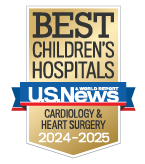Ventricular Septal Defect (VSD)
What is ventricular septal defect (VSD)?
Ventricular septal defect (VSD) is a hole between the ventricles (bottom two chambers of the heart). There may be one or more holes and they may occur in different locations of the ventricular septum (wall that divides the bottom two chambers of the heart). A VSD changes the way that blood flows through the heart.
Causes of ventricular septal defect
Ventricular septal defect is one of the most common forms of congenital heart disease. The exact cause of VSD is unknown. However, risk factors include family history, prematurity, genetic syndromes and other birth differences.
Diagnosing ventricular septal defect
Signs and symptoms of Ventricular Septal Defect include:
-
Heart murmur
-
Slow growth
-
Rapid breathing
-
Acting hungry, but having trouble eating – babies with VSD will sometimes get sweaty and tired when they eat
Testing
These tests can help your care team diagnose VSD and create a treatment plan for your child:
Basic Testing:
-
Electrocardiogram (ECG)— a visual representation of the heart's electrical activity captured via monitors placed on the skin. This test is not painful.
-
Chest x-ray—a test that uses a small amount of radiation to create an image (or picture) within the chest to include the heart, lungs, blood vessels and bones. This test is not painful.
-
Echocardiogram (echo)—a ultrasound of the heart that evaluates the structure and the function of the heart by using sound waves. Still and moving pictures of the heart structures, heart valves, and heart function are recorded for review by a cardiologist. This test is not painful.
Ventricular septal defect treatment
There are several options for treatment including medical management, interventional cardiology and surgery.
Medical management
For a small VSD, your cardiologist may recommend a “wait and watch” approach, to see if the VSD closes on its own. Your pediatric cardiologist will monitor your child until it is closed. If there are symptoms of the heart working extra hard, your child may need medications to manage symptoms. If your child has problems with feeding or gaining weight, they might need high calorie formulas or even tube feeding.
Interventional cardiology
Sometimes, doctors can place a special device to close the VSD during a cardiac catheterization procedure in our dedicated pediatric catheterization lab. If the VSD is the right size/shape and your baby is big enough, they may be a candidate for this kind of procedure.
Surgical management
When it becomes difficult to manage heart failure, or if the child is unable to grow despite medications and nutritional supplementation, your child may need surgery to correct the VSD.
Sometimes a very young child with a large VSD or multiple VSD’s will need pulmonary artery banding to decrease pulmonary blood flow and left to right shunting to protect the lungs from an overflow of blood. These procedures help the heart to continue working at least until they are old enough to have VSD repair surgery. Repair of the VSD can be done with a stitch or patch to close the hole.
What to expect when your baby has ventricular septal defect
If your baby has symptoms of rapid breathing or problems with feeding, they will most likely be admitted to the NICU (Neonatal Intensive Care Unit) for monitoring. A pediatric cardiologist will be assigned to care for you and your baby and prescribe medications that will help. Depending on your baby’s condition, they may be able to go home or need to stay in the hospital for heart and lung support.
If your baby does not need surgery right away, we’ll schedule follow up appointments and repeat testing such as echocardiograms to see if the VSD closes on its own.
If it does not close, your doctor will discuss surgical options with you for future/elective closure. Your child may need to be on medications for a period of time.
Healthy Heart
Sometimes, it’s easier to understand how your child’s heart is different if you have a clearer picture of how a healthy heart works. Experts at the Heart Center have provided the basics to help you learn about the heart’s structure and function.
Choosing your best home for your child’s care

The Heart Center at Children’s Mercy provides comprehensive care for your child as they grow.
When you’re choosing a care team for your child, it can be helpful to see how often our doctors perform certain procedures and how well children do after the surgery is over.
Our surgical team performs hundreds of pediatric heart surgeries each year, often with outcomes that are better than the national average.
Care for your growing child
Following your child’s surgery, they will need close follow-up care with a cardiology provider in the Heart Center. These visits will be spaced out as your baby grows. Even though most children lead healthy, active lives, your child may need cardiology care for their whole life.
Your child’s cardiology provider will continue to monitor via echocardiogram (heart ultrasound) and electrocardiogram (heart electrical activity) for heart valve problems or for problems with the heart’s electrical system (arrhythmia, abnormal heart beat). Since most babies born with Ventricular septal defects will live full lives into adulthood, as they reach an appropriate age, we will help your child transition to an adult congenital heart specialist through our Transition Program.